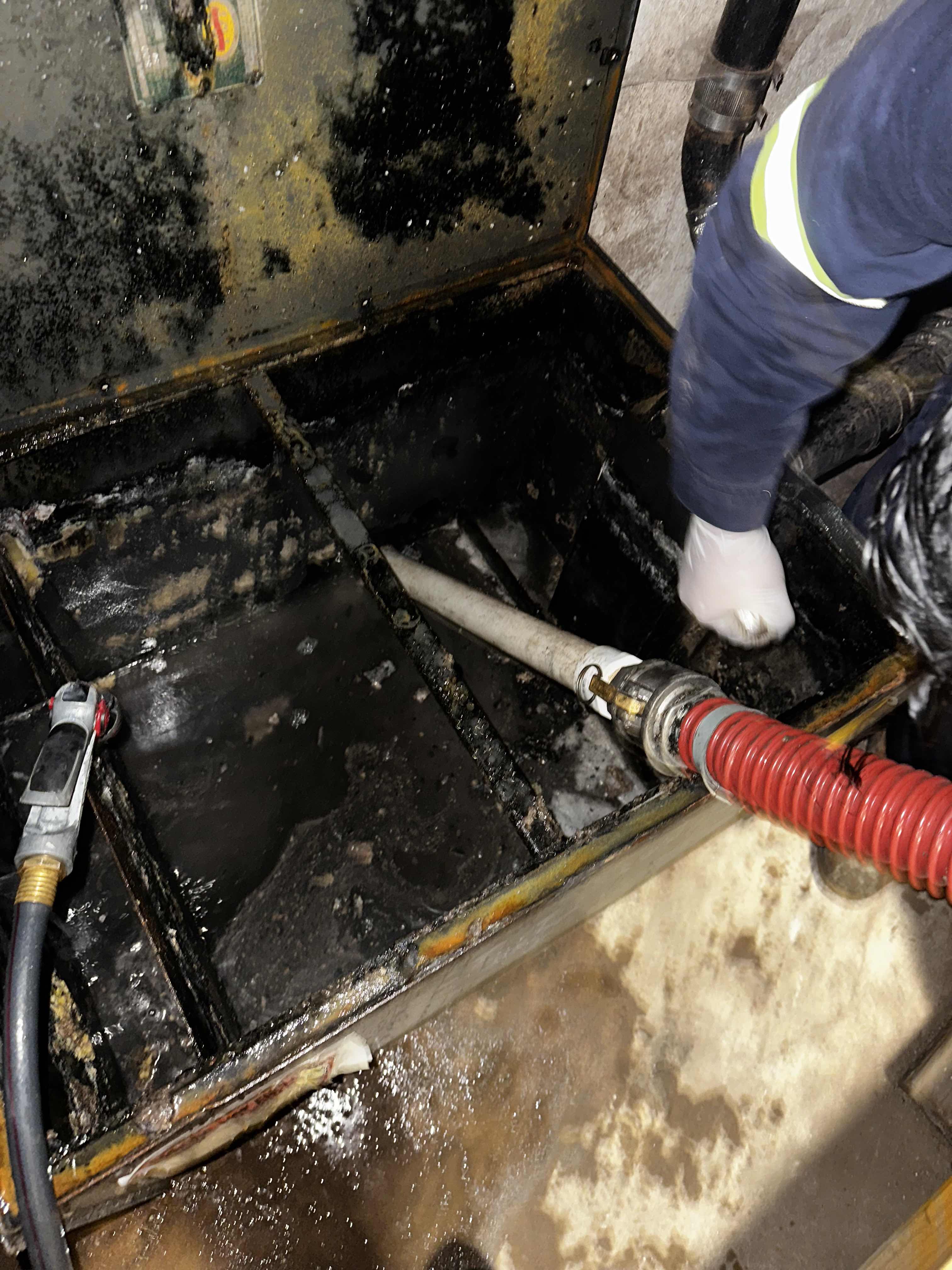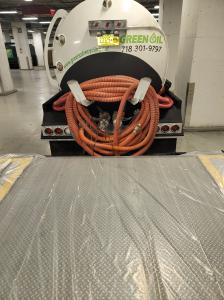Fat Traps and Fatbergs: The History and Consequences for NYC’s Sewers
Grease traps – sometimes called fat traps – are simple plumbing devices designed to intercept fats, oils and grease (FOG) before they enter a sewer line.
BROOKLYN, NY, UNITED STATES, July 13, 2025 /EINPresswire.com/ -- Grease traps – sometimes called fat traps – are simple plumbing devices designed to intercept fats, oils and grease (FOG) before they enter a sewer line. By slowing wastewater so that lighter FOG floats to the top and solids settle out, these traps keep kitchen waste from clogging pipes. In fact, the basic problem is as old as sewers themselves. Ancient Rome’s engineers knew the trouble fats could cause: they often sent slaves or prisoners to slog through cesspits and cut away congealed fat by hand.The first modern solution came in the 19th century. In Victorian-era England and the growing U.S. cities, overflowing sinks and kitchen backups became common, prompting American inventor Nathaniel T. Whiting to patent a grease-trap design in 1884. Whiting’s simple innovation – essentially a buried box on a sink drain – used gravity to separate grease and sediment, collecting it in a chamber while allowing water to flow on. As he described in his patent, the trap was “designed to separate grease and sediment from the water and collect it…while allowing the water to escape without…choking and clogging the sewers". Remarkably, that fundamental “hook-and-hold” design persists today: modern grease interceptors still rely on letting FOG float away from wastewater, then pumping out the collected grease for disposal.
By the mid-20th century grease traps became codified. During World War II, U.S. Army engineers were among the first to require fixed trap capacities on military installations, a rule that later fed into civilian plumbing codes. After the war, trade associations (now the Plumbing & Drainage Institute) researched proper sizing and maintenance. By the 1940s they established charts for trap capacity (e.g. flow rates of 15–20 GPM paired with grease-holding capacities of 30–40 pounds) and recommended frequent cleanings. Today, most codes still insist on regular service – typically monthly – to keep FOG from escaping the trap.
Regulations and enforcement vary by city and state, but big cities like New York have led strict controls. Today any restaurant or kitchen that produces FOG in New York City is required to have an approved grease interceptor. Licensed plumbers must install traps of the right size (calculated by sink and dishwasher flow), and city inspectors routinely check that the tanks are installed correctly and emptied on schedule. The NYC Department of Environmental Protection (DEP) explicitly warns owners to “remove grease as frequently as necessary to avoid exceeding the interceptor’s rated capacity,” and it provides training and signage to staff about proper grease handling.
New York law even distinguishes between used cooking oil (“yellow grease”) and trap sludge (“brown grease”). Both must go to licensed haulers: liquid yellow grease is recyclable (often picked up at no charge since it has market value), whereas thick brown grease is more like solid waste. In fact, New York City encourages businesses to recycle any recoverable grease. Both trap waste and used fryer oil can be collected by certified waste-oil recyclers. Collected grease may be rendered into animal feed or refined into biofuel. (Green Oil Recycling – a local grease-trap and waste-oil service – touts turning millions of pounds of leftover trap oil into biodiesel that powers NYC buses and government vehicles.)
DEP also enforces heavy penalties for noncompliance. Restaurants that ignore grease traps or dump oil illegally face fines – up to $10,000 per violation – from the city. A 2024 Green Oil press release warns that “neglecting grease-trap maintenance and improper disposal of waste oil can lead to serious consequences… including hefty fines of up to $10,000 from the NYC Department of Environmental Protection”. The city even runs public campaigns against so‑called “fatbergs” – massive clogs of grease plus flushed wipes. In 2018 CBS New York reported that almost 90% of sewer backups in the city were caused by grease and wipes. (Workers once hauled over 50,000 tons of such debris to landfills in a single year, at a cost of about $18 million.) Under this “fight the fatberg” initiative, New Yorkers are explicitly told: do not pour grease down the sink or toilet. Instead, cooled grease should be scraped into the trash or sealed in a container for disposal.
With mandates in place, the dirty work falls to grease-trap cleaners. Fat trap cleaning is among the least glamorous jobs in food service maintenance. When traps aren’t pumped often enough, they back up into drains or overflow, causing gurgling sinks and stoppages. Customers and staff complain when septic odors – the product of rotting fat and food waste – waft through the kitchen. In worst cases, overflowing trap contents attract flies, rodents or cockroaches, posing health-code violations. OSHA even warns that large grease pits may accumulate toxic gases (methane, hydrogen sulfide, etc.) and present a fall/engulfment hazard if lids are left unsecured.
As one industry contractor put it, grease trap upkeep “is a rite of passage no apprentice can escape”. Cleaning crews typically wear rubber suits and breathe masks. They use vacuum pumps, scrapers and high-pressure water jets to remove sludge and flush the tank. But even pros are sometimes taken aback by what they find. “Sometimes it’s a flat-out biohazard,” says Mike Russo, a senior technician at Green Oil Recycling. “You lift the cover and there’s foot-thick gunk, old greaseballs, food crusts – even cockroach condos. You gotta suit up and get it out, or the kitchen’s gonna be toast.” His remark echoes one plumber’s tale of opening a trap that was “undersized” for an Asian restaurant: he found it so foul that “the odor… twisted my stomach in knots” and he likened its contents to “chemical warfare”.
Neglecting a trap has swift consequences. Repeated backups and sewage incidents lead to emergency callouts and big repair bills. Health inspectors will shut a kitchen until the mess is cleaned – fines or even temporary closure can follow if traps overflow. In practice, municipalities do require regular servicing. For example, New York City rules say businesses must remove grease often enough to keep the trap’s capacity from being exceeded; industry literature recommends cleaning as frequently as every week. Real-world experience suggests few restaurants actually clean that often – usually a trap-cleaning company is called only when backups appear. “Look,” Russo shrugs, “I tell customers all the time: keep that trap clean, or DEP will hit you with a ten-grand ticket. We’d rather fish out a bucket of gunk now than open a $10,000 bill later.”
Today there is growing emphasis on treating waste grease not just as rubbish, but as a resource. Used cooking oil and trap grease are tightly regulated. New York State law explicitly forbids dumping oil down drains or the ground. Instead, “used oil” from vehicles and FOG from kitchens must be collected and recycled. For instance, many auto shops in New York must accept a few gallons of used motor oil for recycling, and municipalities offer oil-collection events for DIY drivers. Similarly, restaurants must hand their grease to licensed recyclers.
Companies like Green Oil Recycling bridge that gap. They not only empty traps, but haul the brown grease and any waste cooking oil away for processing. Much of that material is sent to rendering plants or fuel refineries. As Green Oil’s marketing material emphasizes, the collected grease is turned into renewable biodiesel used in transit buses and trucks. By one account, the company has helped convert “millions of pounds of carbon dioxide” into cleaner-burning fuel by converting trap oil into biofuel. (In other words, yesterday’s french-fry grease becomes tomorrow’s tailpipe fuel.)
This loop is an upside to proper grease control. “It’s like turning trash into gas,” notes Simone DiLorenzo, an operations manager at Green Oil. “We pump out the trap, ship that brown grease off, and it ends up in a bus tank. Suddenly you feel like your dirty dishwater is doing some good.” The idea is catching on: Green Oil even launched an annual “Waste Oil Awareness Month” in New York to teach restaurants that regular trap service plus waste-oil recycling can save money, protect waterways, and contribute to renewable energy. In short, a clean fat trap is not just a legal requirement – it’s the start of a greener cycle of used-oil disposal.
Gabriel Jean
Safety Group Corp.
+1 212-660-3232
email us here
Visit us on social media:
LinkedIn
Instagram
Facebook
YouTube
Legal Disclaimer:
EIN Presswire provides this news content "as is" without warranty of any kind. We do not accept any responsibility or liability for the accuracy, content, images, videos, licenses, completeness, legality, or reliability of the information contained in this article. If you have any complaints or copyright issues related to this article, kindly contact the author above.


